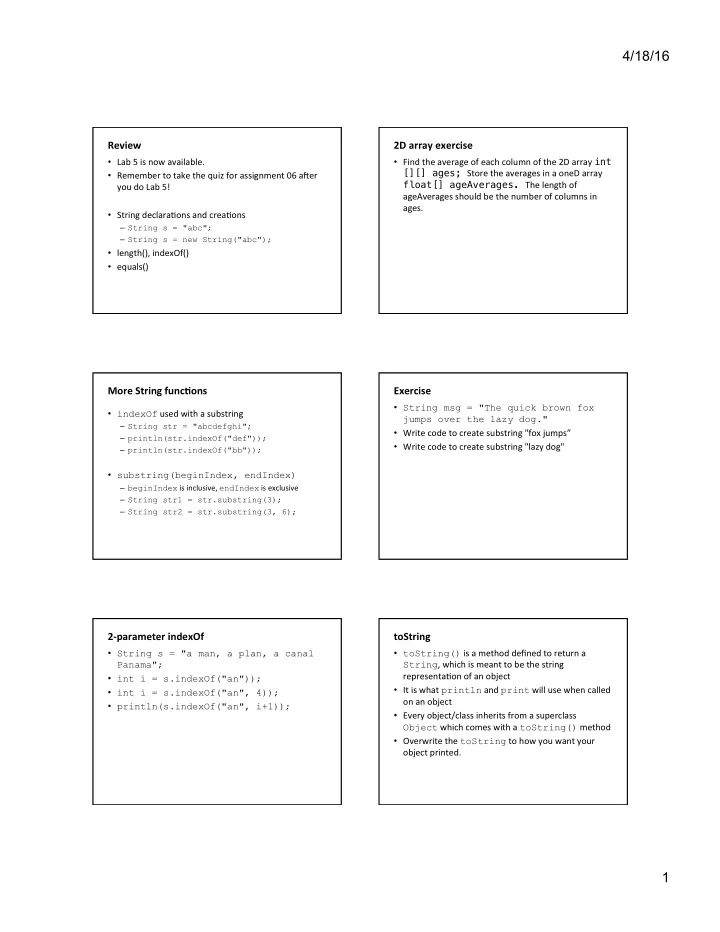

4/18/16 Review ¡ 2D ¡array ¡exercise ¡ • Lab ¡5 ¡is ¡now ¡available. ¡ • Find ¡the ¡average ¡of ¡each ¡column ¡of ¡the ¡2D ¡array ¡ int [][] ages; Store ¡the ¡averages ¡in ¡a ¡oneD ¡array • Remember ¡to ¡take ¡the ¡quiz ¡for ¡assignment ¡06 ¡a<er ¡ float[] ageAverages. The ¡length ¡of ¡ you ¡do ¡Lab ¡5! ¡ ageAverages ¡should ¡be ¡the ¡number ¡of ¡columns ¡in ¡ ages. ¡ • String ¡declaraBons ¡and ¡creaBons ¡ – String s = "abc"; – String s = new String("abc"); • length(), ¡indexOf() ¡ • equals() ¡ More ¡String ¡func7ons ¡ Exercise ¡ • String msg = "The quick brown fox • indexOf ¡used ¡with ¡a ¡substring ¡ jumps over the lazy dog." ¡ – String str = "abcdefghi"; • Write ¡code ¡to ¡create ¡substring ¡"fox ¡jumps” ¡ – println(str.indexOf("def")); • Write ¡code ¡to ¡create ¡substring ¡"lazy ¡dog" ¡ – println(str.indexOf("bb")); • substring(beginIndex, endIndex) – beginIndex ¡is ¡inclusive, ¡ endIndex ¡is ¡exclusive ¡ – String str1 = str.substring(3); – String str2 = str.substring(3, 6); 2-‑parameter ¡indexOf ¡ toString ¡ • toString() ¡is ¡a ¡method ¡defined ¡to ¡return ¡a ¡ • String s = "a man, a plan, a canal String , ¡which ¡is ¡meant ¡to ¡be ¡the ¡string ¡ Panama"; representaBon ¡of ¡an ¡object ¡ • int i = s.indexOf("an")); • It ¡is ¡what ¡ println ¡and ¡ print ¡will ¡use ¡when ¡called ¡ • int i = s.indexOf("an", 4)); on ¡an ¡object ¡ • println(s.indexOf("an", i+1)); • Every ¡object/class ¡inherits ¡from ¡a ¡superclass ¡ Object ¡which ¡comes ¡with ¡a ¡ toString() ¡method ¡ • Overwrite ¡the ¡ toString ¡to ¡how ¡you ¡want ¡your ¡ object ¡printed. ¡ 1
4/18/16 Array ¡of ¡String ¡ split() ¡and ¡splitTokens() ¡ • DeclaraBons ¡ • String s = "a man, a plan, a canal Panama"; – String[] strs = new String[10]; – String[] strs = {"ab", "cde", "f"}; • String[] strs = splitTokens(s, ","); • Write ¡a ¡funcBon ¡that ¡takes ¡an ¡array ¡of ¡strings ¡ strs ¡ • String[] strs = s.split( ¡ ","); ¡ and ¡another ¡string ¡ s ¡and ¡return ¡how ¡many ¡of ¡the ¡ strings ¡in ¡the ¡array ¡contain ¡the ¡string ¡ s ¡as ¡a ¡ • What ¡will ¡be ¡the ¡length ¡of ¡ strs ? ¡ substring. ¡ • What ¡will ¡be ¡the ¡value ¡of ¡ strs[1] ? ¡ • Write ¡the ¡expression ¡that ¡gives ¡the ¡number ¡of ¡ elements ¡in ¡ strs. WHO ¡Tuberculosis ¡data ¡ http://www.who.int/tb/country/data/download/en/index.html // parseFile1 String[] data; void setup() { // Load data from a file as array of strings data = loadStrings("reduced.csv"); for (int i=0; i<data.length; i++) { println(data[i]); } } 2
4/18/16 GapMinder ¡ // parseFile2 hYp://www.gapminder.org ¡ String[] data; class Item { hYp://www.gapminder.org/videos/hans-‑rosling-‑on-‑cnn-‑us-‑in-‑a-‑converging-‑world/ ¡ Item[] items; String country; // Country name int count = 0; int year; // Year ¡ int pop; // Population void setup() { int inc; // Incidences of TB // Load data as array of strings // per 100,000 Hans ¡Roesling ¡ data = loadStrings("reduced.csv"); Item(String country, int year, int pop, int inc) { Karolinska ¡InsBtutet ¡ //create object array this.country = country; //length-1 because we throw away line 0 this.year = year; Stockholm, ¡Sweden ¡ items = new Item[data.length-1]; this.pop = pop; //fill object array this.inc = inc; for (int i=1; i<data.length; i++) { } //split each line into pieces on "," String[] pieces = data[i].split(","); String toString() { items[i-1] = new Item(pieces[0], String msg = "In " + year + ", " + country; int(pieces[1]), msg += " had population " + pop; int(pieces[2]), msg += " and TB incidences per 100k of " + inc; int(pieces[3])); return(msg); } } } for (int i=0; i<items.length; i++) { println(items[i]); } } Map ¡of ¡Science ¡ Flavors ¡and ¡Their ¡Chemical ¡Rela7onships ¡ ¡ Transporta7on ¡Check-‑ins ¡ Corrup7on ¡and ¡Human ¡Development ¡ 3
4/18/16 Corrup7on ¡and ¡Human ¡Development ¡ Every ¡death ¡on ¡every ¡road ¡ A correlation between corruption and development THE use of public office for private gain benefits a powerful few while imposing costs on large swathes of society. Transparency International's annual Corruption Perceptions Index, published on December 1st, measures the perceived levels of public-sector graft by aggregating independent surveys from across the globe. Just five non-OECD countries make the top 25: Singapore, Hong Kong, Barbados, Bahamas and Qatar. The bottom is formed mainly of failed states, poor African countries and nations that either were once communist (Turkmenistan) or are still run along similar lines (Venezuela, Cuba). Comparing the corruption index with the UN's Human Development Index (a measure combining health, wealth and education), demonstrates an interesting connection. When the corruption index is between approximately 2.0 and 4.0 there appears to be little relationship with the human development index, but as it rises beyond 4.0 a stronger connection can be seen. Outliers include small but well-run poorer countries such as Bhutan and Cape Verde, while Greece and Italy stand out among the richer countries. Who ¡owes ¡how ¡much ¡to ¡whom? ¡ 4
Recommend
More recommend